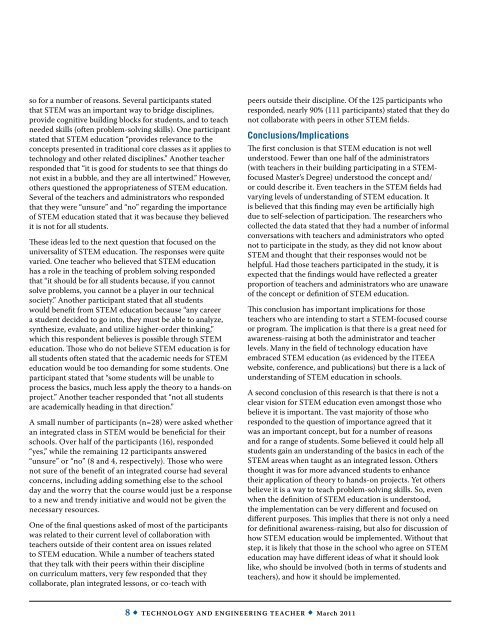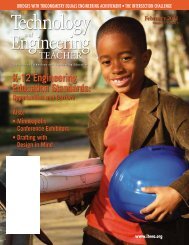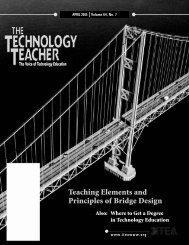March - Vol 70, No 6 - International Technology and Engineering ...
March - Vol 70, No 6 - International Technology and Engineering ...
March - Vol 70, No 6 - International Technology and Engineering ...
You also want an ePaper? Increase the reach of your titles
YUMPU automatically turns print PDFs into web optimized ePapers that Google loves.
so for a number of reasons. Several participants stated<br />
that STEM was an important way to bridge disciplines,<br />
provide cognitive building blocks for students, <strong>and</strong> to teach<br />
needed skills (often problem-solving skills). One participant<br />
stated that STEM education “provides relevance to the<br />
concepts presented in traditional core classes as it applies to<br />
technology <strong>and</strong> other related disciplines.” Another teacher<br />
responded that “it is good for students to see that things do<br />
not exist in a bubble, <strong>and</strong> they are all intertwined.” However,<br />
others questioned the appropriateness of STEM education.<br />
Several of the teachers <strong>and</strong> administrators who responded<br />
that they were “unsure” <strong>and</strong> “no” regarding the importance<br />
of STEM education stated that it was because they believed<br />
it is not for all students.<br />
These ideas led to the next question that focused on the<br />
universality of STEM education. The responses were quite<br />
varied. One teacher who believed that STEM education<br />
has a role in the teaching of problem solving responded<br />
that “it should be for all students because, if you cannot<br />
solve problems, you cannot be a player in our technical<br />
society.” Another participant stated that all students<br />
would benefit from STEM education because “any career<br />
a student decided to go into, they must be able to analyze,<br />
synthesize, evaluate, <strong>and</strong> utilize higher-order thinking,”<br />
which this respondent believes is possible through STEM<br />
education. Those who do not believe STEM education is for<br />
all students often stated that the academic needs for STEM<br />
education would be too dem<strong>and</strong>ing for some students. One<br />
participant stated that “some students will be unable to<br />
process the basics, much less apply the theory to a h<strong>and</strong>s-on<br />
project.” Another teacher responded that “not all students<br />
are academically heading in that direction.”<br />
A small number of participants (n=28) were asked whether<br />
an integrated class in STEM would be beneficial for their<br />
schools. Over half of the participants (16), responded<br />
“yes,” while the remaining 12 participants answered<br />
“unsure” or “no” (8 <strong>and</strong> 4, respectively). Those who were<br />
not sure of the benefit of an integrated course had several<br />
concerns, including adding something else to the school<br />
day <strong>and</strong> the worry that the course would just be a response<br />
to a new <strong>and</strong> trendy initiative <strong>and</strong> would not be given the<br />
necessary resources.<br />
One of the final questions asked of most of the participants<br />
was related to their current level of collaboration with<br />
teachers outside of their content area on issues related<br />
to STEM education. While a number of teachers stated<br />
that they talk with their peers within their discipline<br />
on curriculum matters, very few responded that they<br />
collaborate, plan integrated lessons, or co-teach with<br />
peers outside their discipline. Of the 125 participants who<br />
responded, nearly 90% (111 participants) stated that they do<br />
not collaborate with peers in other STEM fields.<br />
Conclusions/Implications<br />
The first conclusion is that STEM education is not well<br />
understood. Fewer than one half of the administrators<br />
(with teachers in their building participating in a STEMfocused<br />
Master’s Degree) understood the concept <strong>and</strong>/<br />
or could describe it. Even teachers in the STEM fields had<br />
varying levels of underst<strong>and</strong>ing of STEM education. It<br />
is believed that this finding may even be artificially high<br />
due to self-selection of participation. The researchers who<br />
collected the data stated that they had a number of informal<br />
conversations with teachers <strong>and</strong> administrators who opted<br />
not to participate in the study, as they did not know about<br />
STEM <strong>and</strong> thought that their responses would not be<br />
helpful. Had those teachers participated in the study, it is<br />
expected that the findings would have reflected a greater<br />
proportion of teachers <strong>and</strong> administrators who are unaware<br />
of the concept or definition of STEM education.<br />
This conclusion has important implications for those<br />
teachers who are intending to start a STEM-focused course<br />
or program. The implication is that there is a great need for<br />
awareness-raising at both the administrator <strong>and</strong> teacher<br />
levels. Many in the field of technology education have<br />
embraced STEM education (as evidenced by the ITEEA<br />
website, conference, <strong>and</strong> publications) but there is a lack of<br />
underst<strong>and</strong>ing of STEM education in schools.<br />
A second conclusion of this research is that there is not a<br />
clear vision for STEM education even amongst those who<br />
believe it is important. The vast majority of those who<br />
responded to the question of importance agreed that it<br />
was an important concept, but for a number of reasons<br />
<strong>and</strong> for a range of students. Some believed it could help all<br />
students gain an underst<strong>and</strong>ing of the basics in each of the<br />
STEM areas when taught as an integrated lesson. Others<br />
thought it was for more advanced students to enhance<br />
their application of theory to h<strong>and</strong>s-on projects. Yet others<br />
believe it is a way to teach problem-solving skills. So, even<br />
when the definition of STEM education is understood,<br />
the implementation can be very different <strong>and</strong> focused on<br />
different purposes. This implies that there is not only a need<br />
for definitional awareness-raising, but also for discussion of<br />
how STEM education would be implemented. Without that<br />
step, it is likely that those in the school who agree on STEM<br />
education may have different ideas of what it should look<br />
like, who should be involved (both in terms of students <strong>and</strong><br />
teachers), <strong>and</strong> how it should be implemented.<br />
8 • <strong>Technology</strong> <strong>and</strong> <strong>Engineering</strong> Teacher • <strong>March</strong> 2011
















